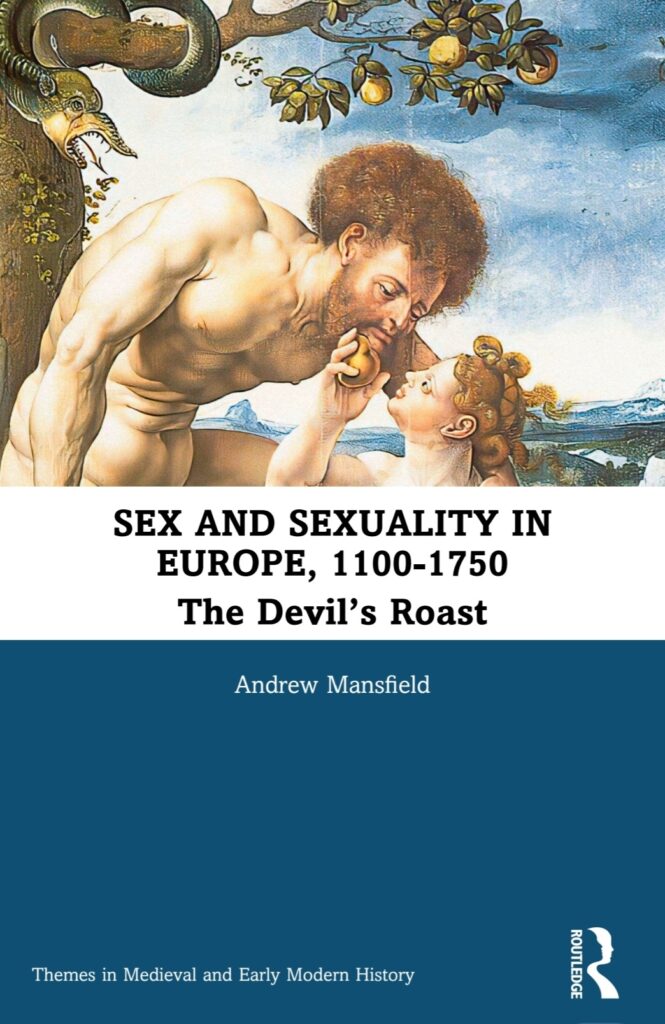Andrew Mansfield’s Sex and Sexuality in Europe, 1100-1750: The Devil’s Roast (Routledge, 2023) offers an engaging overview of the history of ‘sex’ and ‘sexuality’ across Europe in the medieval and early modern periods. Challenging the divide between ‘medieval’ and ‘early modern’ views and practices of ‘sex’ and ‘sexuality’, Mansfield maintains that there was significant continuity between 1100 and 1750. His book also offers a fresh perspective on the origins of sexual change as characterized in the 18th-century ‘sexual revolution’.
What are the main arguments of your book?
There are four main arguments or conclusionary themes to the book, five when you include the discussion of periodisation, which we can return to. The themes are the passions, the imagination, the ‘two worlds’ motif and subordination. In terms of human nature, throughout the timeframe of the book the power of sexual desire and attraction has long been recognised and warned about. Sex is one of the key drivers for human beings, so it has a special and privileged place in society. Subsequently, its power and significance to people have been acknowledged, and there has been a need to control it for many reasons; for example, the church believed that it reflected the basic animalistic passions of humanity and must be overcome to avoid sin. The book reveals that the need to subordinate the passions is juxtaposed with the desire people possessed to engage in sexual behaviours, ideas that came to be philosophically explored in the early Enlightenment.
Another important factor in what it means to be human is the strength of the imagination. The imagination worked dichotomously: dwelling on the torments of hell that awaited sexual sinners but also thinking about sexual desires. The book locates a strong undercurrent of fantasy between 1100 and 1750, and a prurience in the public for material relating to sex and libidinous behaviour. Moreover, sex and sexuality are seen to pose a hazard in the imagination to the established order, notably threatening patriarchal society and European ‘phallic culture’ as women are viewed not to be behaving as they should.
This contrast between the expected and the unexpected is illustrated by what I have labelled as the ‘two worlds, three cultures’ motif. Building on the work of Guido Ruggiero, the book consistently explores the theme of the presence of two worlds—a Christian world of chastity and marriage for procreation, and a world of fornication and sexual attraction. It also explores at least three cultures: a clerical elite, a secular elite and a popular culture.
In fact, there are a number of divergent worlds within the book, with one of the most apparent being the world of men and the world of women. Such a separation leads to an underlining of the ‘double standard’ discussed by Keith Thomas, and we find that areas of historiographically perceived change such as the 18th-century’s ‘sexual revolution’ is true for men but not so for women. This leads to the final conclusion of subordination. As the book highlights, although sex is used in numerous ways to subordinate people it is frequently women that are the central focus. The regulation of sex is perceived to be for the good of society, but in terms of the church and then of the state, control over the sexual drive provided them with a great deal of influence over how people lived their lives.
Does your work challenge or correct historiographical narratives in the field of the history of sexuality?
The book acts as an introduction to the field of the history of sexuality and therefore delineates key themes, ideas and theories from the historiography while drawing its own conclusions. It is particularly aimed at undergraduates and those new to the field, so it offers a treatment of major discussions within the history of sexuality but does so not only from a historical perspective but also engages with psychology, sociology, anthropology and scientific ideas. The conclusions (above) put forward key themes that become evident when reading the book and dealing with the years 1100 to 1750.
Another aspect of the book that is important is that it incorporates ideas and behaviour from across Europe. Many works within the field only look at western Europe, but Sex and Sexuality in Europe incorporates elements from eastern and western Europe to provide a more holistic approach to the subject of sex and sexuality—although, of course, ‘sex’ and ‘sexuality’ are modern terms. Another important part of the work is that the fourth chapter, ‘Exploration’, examines Europeans when they are interacting with others from around the world and the impact that this has had on both Europeans and these ‘others’.
Your book explores the timeframe between 1100 and 1750. Why this specific timeframe?
Routledge, the publisher! No, in all seriousness the work is part of Routledge’s ‘Themes in Medieval and Early Modern History’ series and the editors and I wanted to explore continuity and change between the two ‘periods’. What the book elucidates is that, despite ranging over a 650-year timeframe, there is a great deal of continuity when examining European sex and sexuality. Many of the central themes and ideas that concerned Europeans in early ‘Christendom’ in the 12th century had relevance in the first half of the 18th century and the early Enlightenment. This is due, in part, because key institutional structures that organised society such as the church (religion) and state were in place. Rather than a rupture between 1100 and 1750, much of the change that occurred was slow-burning and gradual. It is true to say that changes in attitudes towards sex and sexuality took place from the 17th century, but the book makes the case that in terms of the field of the history of sexuality there really is no ‘early modern’ period. Rather, there was a longer ‘premodern’ period due to the levels of continuity.
What sources were vital to your research?
The work was conceived of as an intellectual history of sexuality and is therefore textually based, although ranging across several disciplines. There is so much textual evidence for the field both in terms of primary and secondary sources. I wanted not only to offer an overview of the history of sexuality between 1100 and 1750 but also explore how Europeans were thinking and writing about sexual matters. This was done while including other disciplines—which intellectual history lends itself to—so that a panoramic view could be created that was contextual and took the reader on a journey into a different time with different attitudes and behaviours. The use of historical context is important to the book as it is often lacking in the history of sexuality. Mindful that the book is an introduction, I hoped that confronting this issue would interpret what happened culturally, socially and historically to reinforce a wider contextual understanding of sex and sexuality.
Lastly, are there any projects you’re currently working on?
My research has two strands in effect, the history of sexuality and the history of political thought. For my next monograph, entitled Best Men and Servile Crews: aristocratic constitutionalism and the creation of early modern British oligarchy, I have moved over to the latter to provide a book for Oxford University Press. While the dominance of the British aristocracy on society and in politics up until the early 20th century has been widely acknowledged, this recognition has not been readily transferred to political theory which justifies the necessity of aristocratic rule. Instead, there is a propensity amongst contemporary scholars in several fields to concentrate on the progression of democracy, popular sovereignty and republicanism. The emphasis in such analyses is on the ‘people’ or the ‘popular’ element within the constitution and sovereignty, consistently set out as a teleology to the present day. This, too, often relies upon a misleading symbiosis between Parliament and the ‘popular’ element of government, in which the former’s representation of the latter is equated with the active participation of the ‘people’ in sovereignty.
Moreover, it gives rise to a narrative in which the people are portrayed as rejecting absolute monarchical authority enabling Parliament to gradually achieve supremacy in the 18th century for the people. On one level, this is true, but at a more foundational level, these changes were not enacted by or for the people, but a Parliament of nobility and gentry: the elite. Following the Restoration of Charles II (1660), the nobility enjoyed a power and status not seen for two hundred years. The perceived threat posed by James II saw many exercise their medieval legal rights to form a new constitution to protect the nation and their own interests. These interests, along with a view of society and the world, led to British oligarchy. The book will draw these elements together to offer a new examination of British political history and theory that accords with the social context during this timeframe, while disrupting the paradigmatical historiography of the Cambridge School (notably J.G.A. Pocock and Quentin Skinner) for the period covered.
Andrew Mansfield is a Research Associate in the Department of History at the University of Sussex (U.K.). He specialises in the history of sexuality and the history of political thought, and is a Fellow of the Royal Historical Society.

